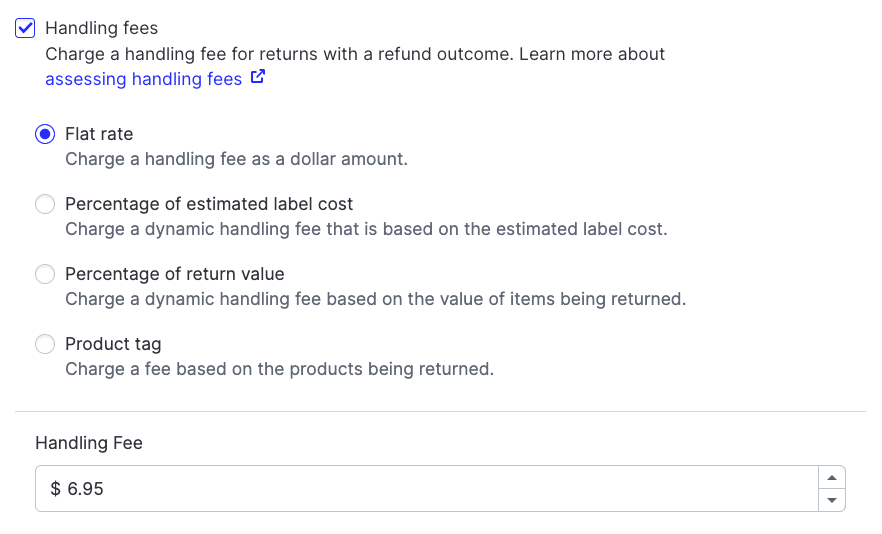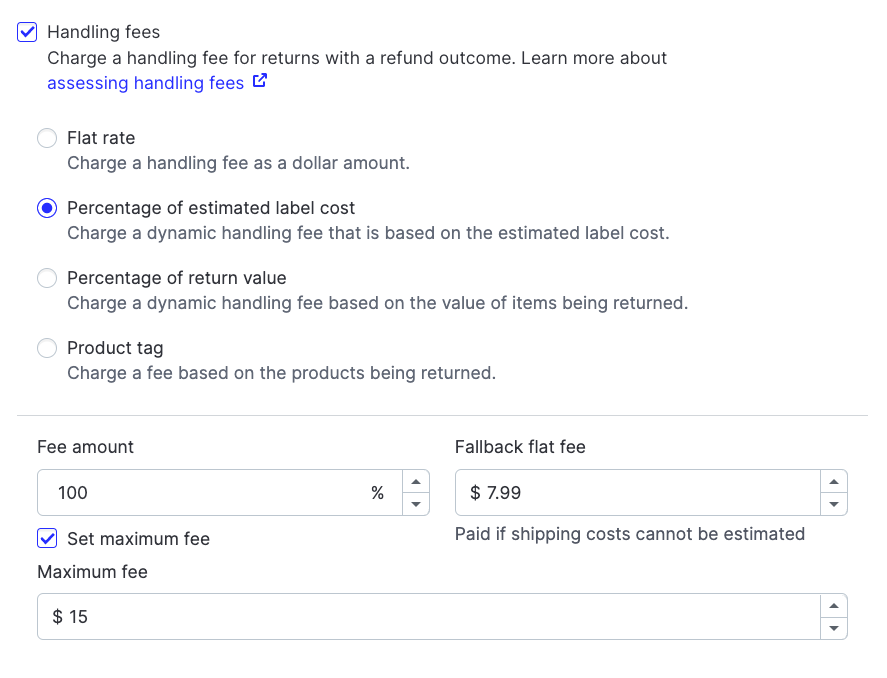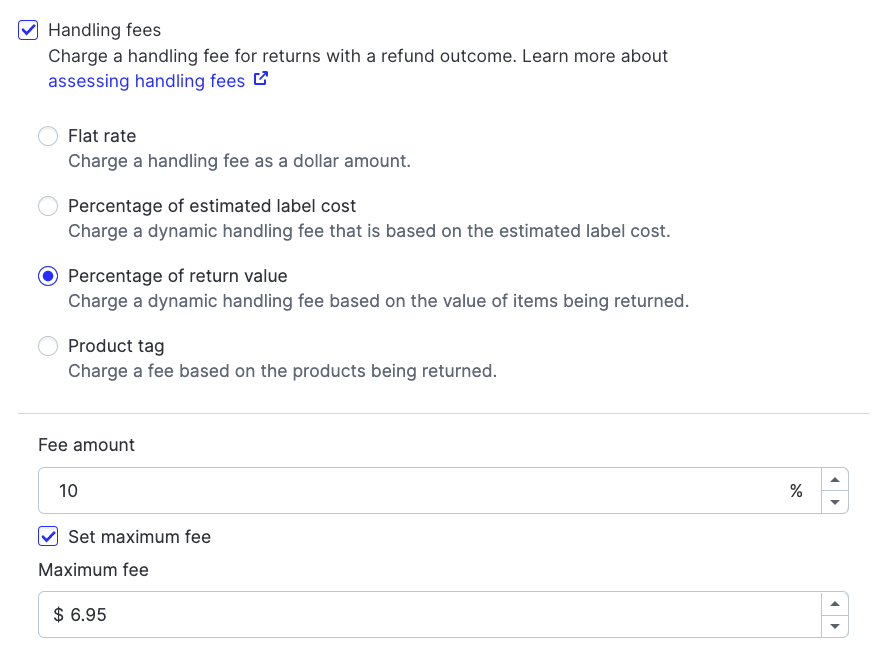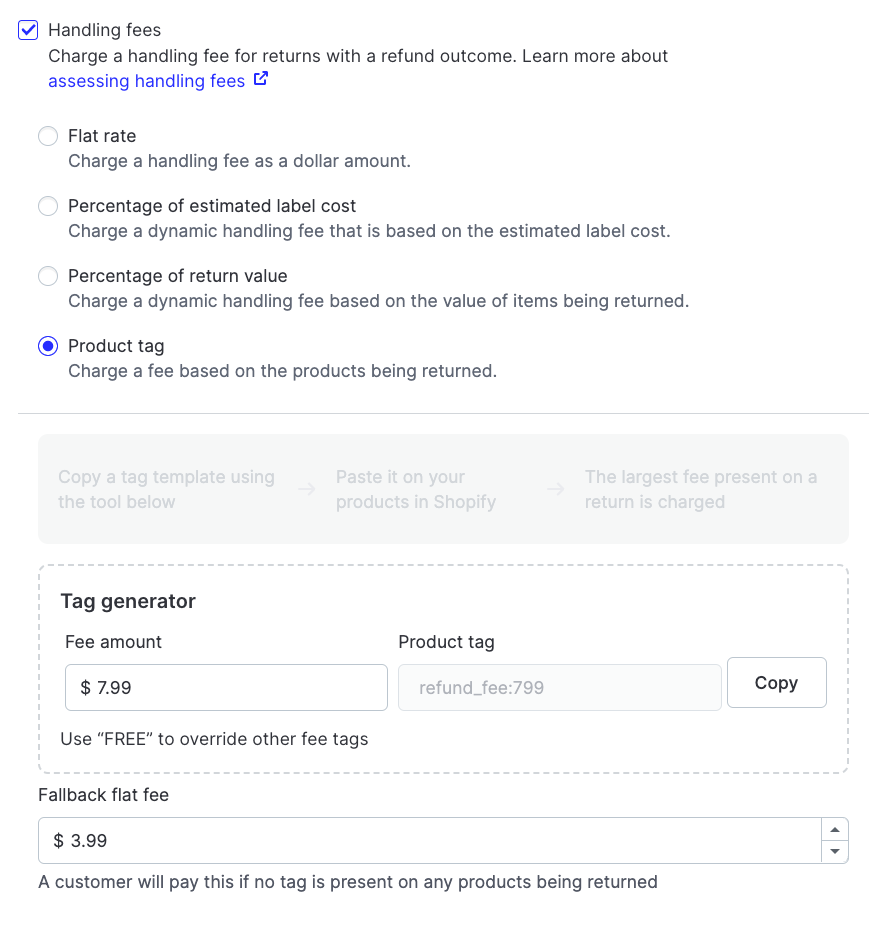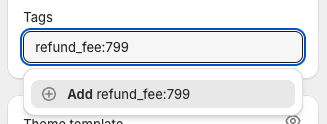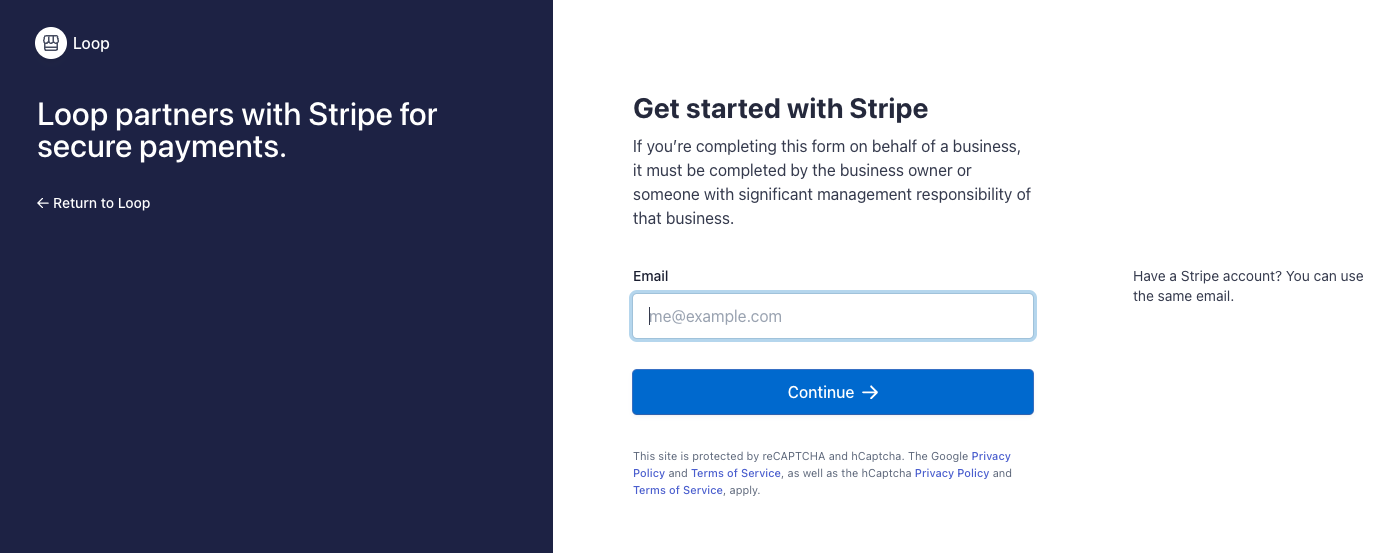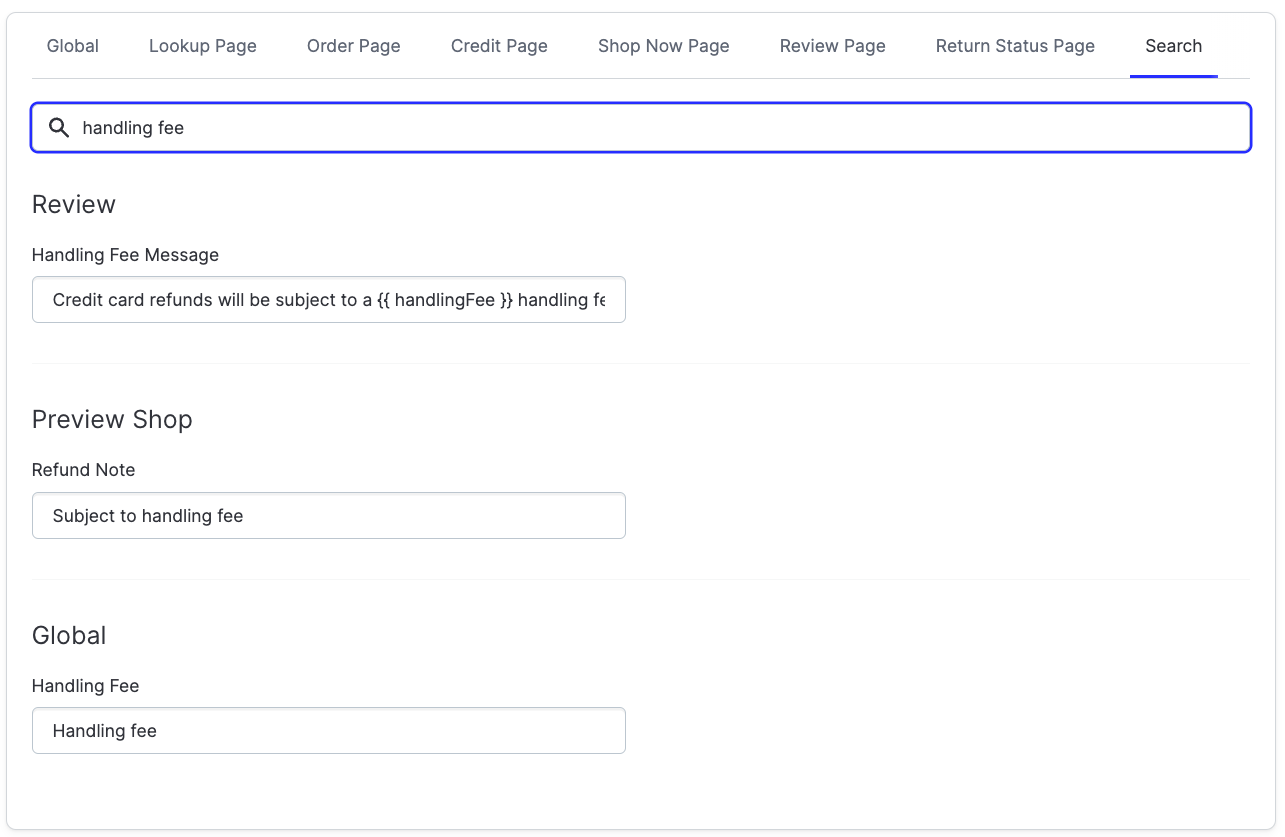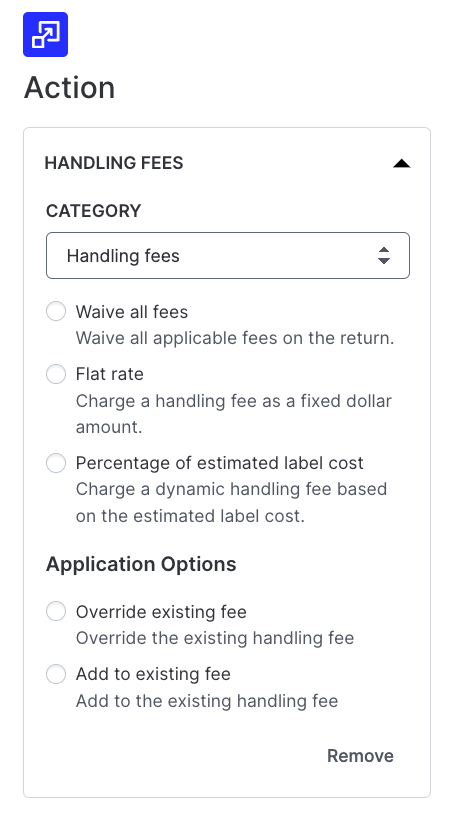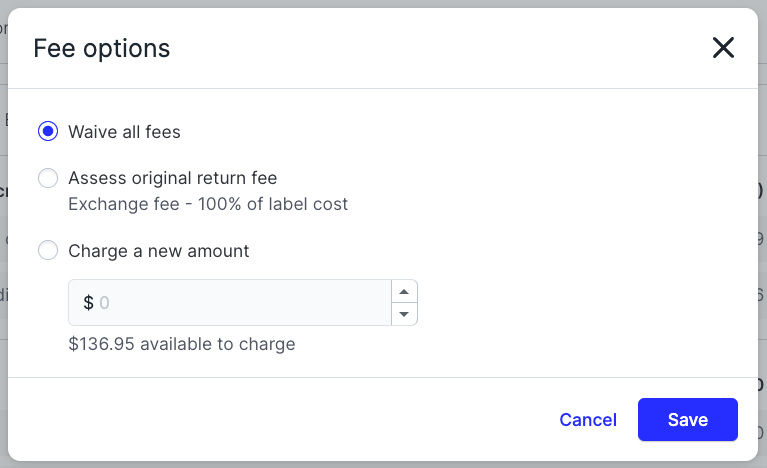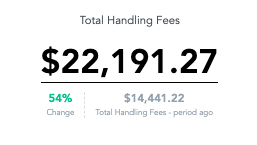Handling Fees
OVERVIEW
This article reviews setting up and customizing handling fees in the Loop admin. Handling fees will primarily be assessed by the Return Policy settings but can also be charged, waived, or added to by Loop's Workflows or Edit Return tools.
Why it matters
Merchants can recover some or all of the shipping costs on returns by applying a handling fee. They can also configure the handling fees to incentivize customers to choose a return outcome that doesn't have a fee associated with it. For example, if a refund has a $9.99 handling fee, but a store credit return has no fee added, that could help incentivize the customer to choose store credit over a refund to their original payment method.
Important: Be sure to make the merchant's customers aware of any fees in the merchant's return policy on their website.
Fee types and setup
Merchants can configure handling fees separately for Refunds, Store Credit, and Exchanges. They can also configure the fees on or off for each return outcome by going to the Loop admin > Returns management > Policy settings > Return policies. Click Edit on the policy to be edited, select the "Handling fees" checkbox, and choose one of the four paradigms described under Choosing the fee type below.
Note: If the merchant only charges handling fees for specific products or scenarios, please review the section Other ways to manipulate handling fees.
Choosing the fee type
Fees on each outcome can be configured using one of four fee paradigms:
Flat rate - Charge a handling fee as a dollar amount.
Percentage of estimated label cost - Charge a dynamic handling fee that is based on the estimated label cost.
Percentage of return value - Charge a dynamic handling fee based on the value of items being returned.
Product tag - Charge a fee based on the products being returned.
Read below for more information on setting up each of these types.
Flat rate
Loop will charge a flat fee on every return outcome that has this fee enabled.
To set this up, go to the Loop admin > Policy settings > Return policies > Edit and enable the fee options by selecting the "Handling fees" checkbox.
Once enabled, select the Flat rate option and input the fee amount in the Handling Fee field.
Percentage of estimated label cost
Loop will charge a dynamic fee that is based off of a percentage of the estimated label cost when the rate is initially pulled.
Important: Fees by percentage of estimated label cost are currently only available if using EasyPost, Ship by Loop US Domestic, or Ship by Loop Worldwide. Services such as SEKO and Cycleon are not currently supported for this fee type.
To set this up, go to the Loop admin > Returns management > Policy settings > Return policies > Edit and enable the fee options by selecting the "Handling fees" checkbox.
Once enabled, select the Percentage of estimated label cost option and input the fee amount percentage. This percentage can be anywhere between 1-300% of the label cost.
Note: When a customer is going through the return flow, as soon as they hit the "Continue with Return" button, Loop will estimate the label cost. This will be the amount used to assess the fee. Though the exact amount is unlikely to change before the customer completes their return, it is possible—therefore this is a percentage of estimated label cost.
Tips:
Loop also recommends setting up a Fallback flat fee in case the shipping costs cannot be estimated. In that instance, Loop will fall back to charging the Fallback flat fee to the customer.
A Maximum fee can also be added to put a cap on the fee that is charged to the customer. This is helpful for merchants who sell heavy or bulky items.
Percentage of return value
Loop will charge a dynamic fee based on the value of items being returned with the ability to set a maximum fee. This allows merchants to charge a higher handling fee for customers returning more items.
To set this up, go to the Loop admin > Returns management > Policy settings > Return policies > Edit and enable the fee options by selecting the "Handling fees" checkbox.
Once enabled, select the Percentage of return value option and input the percentage in the Fee amount field.
Product tag
Loop will charge a flat fee based on a product tag that can vary by product type. If a product does not have a tag, Loop will use the Fallback flat fee, if set up.
To set this up, go to the Loop admin > Returns management > Policy settings > Return policies > Edit and enable the fee options by selecting the "Handling fees" checkbox.
Once enabled, select the Product tag option and follow these steps:
In the Fee amount field, type in the fee for the product(s). Loop will automatically generate a product tag for the fee.
Copy the product tag Loop created and navigate to the merchant's Shopify store.
In Shopify, add the product tag to the Tags section of the product(s) this fee will apply for.
Notes:
If a return has multiple fee tags, Loop will select the highest fee tag and apply it to the return.
If the merchant wants certain products to be exempt entirely from handling fees, please use "refund_fee: FREE" as a tag. If a product in a return has the FREE return tag, the entire return request will not be assessed a handling fee.
Charging handling fees on exchanges
Handling fees on refunds and store credit returns are deducted from the amount being issued back to the customer. Since there is no amount being issued back to the customer during a variant exchange, a separate charge needs to be collected by Stripe to assess a handling fee.
To connect Stripe to Loop, navigate to Returns management > Tools & integrations > Integrations in the Loop admin. In this tab, there is a Stripe tile that can be toggled on. Toggling on the Stripe tile will begin the account creation process or allow sign-in for an existing account.
Note: If there is no Integrations section in the merchant's Loop admin, please reach out to the merchant's Merchant Success Manager or support@loopreturns.com for assistance.
Additional information on using Stripe with Loop:
Stripe will collect 2.9% plus $.30 for each fee captured.
The 2.9% only collects from the fee amount.
These fees are assessed and tracked separately within Stripe. Loop does not have this information and the transaction is not recorded in Shopify either.
Cost and payment details are all tracked separately in Stripe. Loop has limited access to this data for security reasons from Stripe.
Payouts are issued via Stripe.
Customizing verbiage
By default, Loop will display the handling fee to the customer as a "Handling fee." Merchants often prefer to customize the name of this fee. Some examples include "Return fee," "Shipping & Handling fee," and "Restocking fee."
The text of the handling fee can be customized by navigating to Returns management > Shopper experience > Portal customizations > Edit all content and searching for "handling fee." For consistency, be sure to update the text in all 3 fields that appear.
Important: When updating verbiage in the content section of the Loop admin, do not update any text that appears within double brackets (for example, {{ handlingFee }} as shown above). The double brackets indicate a dynamic variable in the code that will pull in values depending on the return (in the above example, it will pull in the fee amount). If needed, the variable can be removed completely.
Other ways to manipulate handling fees
Workflows
When charging handling fees in specific situations, rather than for all returns, Loop's Workflows tool should be used to assess the fee instead of setting up the handling fees in the Return Policy settings. Workflows can also be used in scenarios where an additional fee needs to be charged on top of the main Return Policy fee or if a fee needs to be waived (for example, product arrived damaged). Below are the options for actioning on handling fees via Workflows:
Edit Return
When a return has already been submitted but is still open and unprocessed, the Edit Return feature can be used to manipulate fees on that return. This can be helpful if a customer returns their product damaged or soiled and an increased fee needs to be applied. With Edit Return enabled, there will be a Fee line with a clickable Options link in the return request.
On the Fee line, select Options and a modal will pop up with the options to Waive all fees, Assess original return fee, or Charge a new amount. If no fee was originally present on the return request, then the only option will be to Charge a new amount.
Multi-currency handling fees
When selling in multiple currencies, there are a few things to note about setting up and using handling fees in the Loop admin:
In the Loop admin:
When setting up a handling fee in the Loop admin, the currency shown in the admin will be the shop's currency.
The handling fee(s) that are set up via the Workflows will behave the same as the handling fee(s) in the Return Policy, where there will be no conversion.
In the shopper portal (customer experience):
If the customer is in the same currency as shop currency, they will see the handling fee displayed in their currency/the shop's currency.
If the customer is in a different currency than shop currency, their return and any associated handling fees will be in shop currency, but the refund will be converted to their currency. Store credit will remain in shop currency.
Reporting on handling fees
If you want the ability to report on your total handling fee charges, there are numerous Loop reports within the Analytics tab that will surface that information for you to easily download and share.
Specifically, the Logistics dashboard will default to showing your total handling fees for the set date range and give a comparison to the previous range
You can also see specific fees by return in your Return Totals report .
Plan information
Flat Rate Handling Fees are available in the Return Policy settings of all Loop plans. To check if the merchant's plan includes charging handling fees on exchanges, the dynamic fee types, Workflows, or Edit Return, please review the Pricing page on Loop's website.
If the merchant wants to add any of these features, please contact the merchant's Merchant Success Manager to amend the account.
FAQ
How are handling fees charged? Handling fees on refunds and store credit will be deducted from the amount being issued to the customer, so this will not appear as a separate charge. Since no amount is being issued back to the customer in an exchange, Stripe will be needed to collect handling fees on exchanges (please see the Charging handling fees on exchanges section).
What fee gets applied when a return includes both a refund and an exchange? Loop calculates the value of exchanged product vs. the overall return value. If the value of exchanges exceeds 50% of the total return value, the return is deemed an exchange and any exchange fees will apply. Conversely, if the value of exchanged product is less than 50% of the total return value, the return is deemed a refund and any store credit or refund fees will apply.
Can I set up a store credit bonus and a handling fee on store credit? No, since the handling fee is deducted from the amount being issued back to the customer as store credit, this would cancel out any bonus that would be offered as well, so only one option can be selected here.
What are some best practices around charging handling fees? We recommend not charging handling fees on exchanges to incentivize customers to make an exchange over a refund. We often recommend charging a higher handling fee on refunds compared to other outcomes to discourage customers from choosing a refund.
What amount should I charge for a handling fee? This will vary greatly on product type and product size if the main goal is for the fee to cover label costs. Average handling fees for apparel brands is $7, for home goods is $15, and for footwear is $9.
Please contact support@loopreturns.com with any additional questions.

